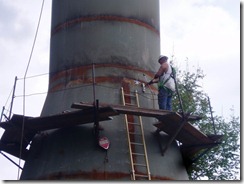An In-depth Review of Storage Tank Welding Assessment Standards and Methodologies for Improved Weld High Quality and Efficiency
The value of welding examination criteria in the production of storage tanks can not be overstated, as they serve as the backbone for making certain weld honesty and functional dependability. Various inspection techniques, consisting of aesthetic evaluations and advanced non-destructive testing approaches, are important in determining potential flaws that can jeopardize performance.
Value of Welding Evaluation Standards

Welding assessment standards encompass an array of requirements, including material specifications, welding procedures, and qualifications of personnel associated with the welding procedure. By applying these requirements, companies can systematically identify and remedy potential issues, consequently decreasing the chance of pricey repairs or devastating failings. Furthermore, extensive assessment practices foster a culture of liability and accuracy, encouraging welders to preserve high degrees of workmanship.

Usual Welding Inspection Methods


Ultrasonic Examining (UT) is another common method, using high-frequency acoustic waves to identify inner defects that might not show up externally. This technique is especially effective for recognizing voids or additions within the weld metal. Magnetic Bit Testing (MT) is likewise commonly utilized, particularly for ferromagnetic materials, as it reveals surface area and near-surface flaws through the application of electromagnetic fields and ferrous bits.
Additionally, Fluid Penetrant Testing (PT) detects surface-breaking issues by applying a penetrant to the weld and afterwards utilizing a developer to attract out the penetrant. Each of these techniques adds to an extensive inspection method, guaranteeing that welds fulfill the stringent quality requirements called for in storage tank construction.
Regulatory Standards and Compliance
Regulatory standards and conformity are essential parts in making certain the safety and security and reliability of bonded frameworks in container construction - Tank Welding Inspection. These requirements offer to establish minimum demands for product residential properties, welding procedures, and assessment techniques, thus lowering the threat of structural failures and over at this website improving total performance
Secret companies, such as the American Culture of Mechanical Designers (ASME) and the American Welding Society (AWS), supply standards that are extensively adopted in the market. Conformity with these standards not only makes sure adherence to ideal techniques but likewise satisfies lawful and legal obligations, safeguarding the rate of interests of stakeholders.
Regulative bodies usually mandate adherence to specific codes, such as ASME Code Section IX for welding certifications and API 650 for welded storage tanks. These codes detail needs for welding strategies, qualifications of personnel, and testing methods to confirm weld stability.
Routine audits and assessments are important to keeping conformity, as they aid recognize inconsistencies from developed criteria. Non-compliance can cause substantial fines, job hold-ups, and security risks. Therefore, a durable understanding of regulative requirements and a commitment to compliance are paramount in achieving high-grade and dig this durable bonded container frameworks.
Non-Destructive Checking Techniques
How can the honesty of bonded frameworks be guaranteed without causing damages? Non-destructive screening (NDT) techniques supply a durable service, enabling assessors to evaluate weld high quality without endangering the material - Tank Welding Inspection. Among the most usual NDT strategies are ultrasonic testing (UT), radiographic testing (RT), magnetic fragment screening (MT), and dye penetrant testing (PT)
Radiographic testing includes passing X-rays or gamma rays through the weld, developing images that disclose structural flaws such as cracks or gaps. This method is vital for evaluating the honesty of complex welds.
Magnetic fragment testing is fit for ferromagnetic products, where electromagnetic fields disclose surface and near-surface stoppages. Dye penetrant screening makes use of a liquid color to highlight surface-breaking flaws, making it an efficient approach for non-porous materials.
Each of these NDT techniques has distinctive advantages, enabling thorough assessments customized to details materials and welding procedures. By applying these techniques, markets can make certain the see this here reliability and security of bonded frameworks, ultimately improving general efficiency.
Enhancing Weld Quality Through Assessment
Reliable inspection plays an essential function in improving weld top quality, working as a vital checkpoint in the fabrication process. By identifying prospective flaws early, evaluations alleviate the threat of jeopardized architectural stability and make sure conformity with sector criteria. Using a mix of aesthetic examinations, non-destructive testing (NDT) methods, and mechanical assessments, inspectors can spot issues such as porosity, cracks, and incomplete fusion.
Implementing a robust inspection protocol not just boosts the total top quality of welds yet likewise promotes a culture of responsibility among welders and fabricators. Regular training and qualification of examination employees make sure that they are furnished with the needed skills to recognize and address possible troubles successfully. This positive method minimizes rework and linked prices, eventually contributing to project performance.
Moreover, extensive documentation of inspection searchings for offers valuable understandings right into repeating concerns, assisting in constant improvement in welding techniques. By leveraging sophisticated modern technologies, such as automated ultrasonic screening or digital radiography, weld top quality can be improved through more exact evaluations. Finally, an extensive inspection procedure is important in achieving top quality welds, making certain security, integrity, and longevity in container fabrication.
Final Thought
To conclude, the execution of rigorous storage tank welding inspection requirements and methodologies is necessary for guaranteeing weld honesty and performance. By using a mix of visual assessments, non-destructive testing techniques, and adherence to governing standards, companies can properly identify and alleviate potential problems. Cultivating a culture of responsibility amongst welders further improves the high quality of welding processes. Ultimately, these methods add to lowered structural failures, lower repair service expenses, and boosted operational effectiveness within the market.